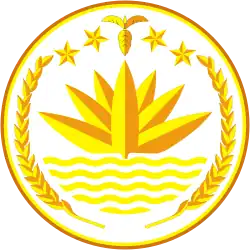| Regions with significant populations | |
|---|---|
| Odisha | 516,402 |
| West Bengal | 108,707 |
| Bangladesh | 2,000 |
| Languages | |
| Lodhi | |
| Religion | |
| Majority Hinduism (99.7%) Minority Buddhism (0.2%) and Animism (0.1%)[1] | |
| Related ethnic groups | |
| Mundas, Ho, Santhal and other Mundari speaking people | |
The Sabar people (also Shabar and Saora) are one of the Adivasi of Munda ethnic group tribe who live mainly in Odisha and West Bengal. During the colonial period, they were classed as one of the 'criminal tribes' under Criminal Tribes Act 1871, and suffer from social stigma and ostracism in modern times.[2][3]
Also known as Saora, the Sabar tribe finds mention in the Hindu epic Mahabharata,[4] while in some parts of East Singhbhum district mainly in Musabani, they are known as in Kariya.[5] Noted writer and activist Mahasweta Devi is known for working with these forest tribals.[6]
This reclusive tribe is found primarily in Odisha[7] and in Midnapore District of West Bengal.
History
The traditionally forest-dwelling tribe lack experience in agriculture, and rely on the forests for their livelihood. In recent years, with the spread of the Naxalite rebellion in the area, the police often restrict their access to the forest. In 2004, five persons in the Sabar village of Amlasole, in Midnapore district, died after several months of starvation, [8] leading to a national media furore. Subsequently, Durbar Mahila Samanway Committee (DMSC) started a school in the area, funded partially by sex workers from Kolkata.[9]
In June 2008, the Sabar suffered severe flooding in many of their West Bengal villages, and then received large amounts of aid from Catholic missionaries.
Hundreds of Sabars migrated to present-day Bangladesh during the colonial period to work as tea garden labourers. Today, there are around 2000 of them residing the northeastern district of Moulvibazar, in areas such as Nandarani, Harinchhara and Rajghat.[10]
In Gplot which is in Sundarbans, under Patharpratima block which is in South 24 parganas it has been observed that there is presence of Sabars, who have migrated from Midnapore district of West Bengal. Currently there are 2500-3000 people of Sabar community residing there.
References
- ↑ "Sabar in India". Joshua Project.
- ↑ Dilip D'Souza on the Sabar tribe Rediff.com, 16 October 1999.
- ↑ Accused Of Being Accursed by Dilip D'Souza, Rediff.com, 10 June 1999.
- ↑ Orissa Tribes bharatonline.com'.
- ↑ Sabar Tribe india9.com.
- ↑ Hazaar Chaurasi Ki Ma - Mahashweta Devi Tehelka, 11 September 2004.
- ↑ Sabar tribals go on ‘Bharat Darshan’ The Hindu, 27 February 2008.
- ↑ "Red Faced". indiatoday.com. India Today. 28 June 2004. Retrieved 17 October 2015.
Budhu Sabar, who lost his father Samay and sister Mongli earlier this year, has no doubt they starved to death. "My father had nothing but water for almost a fortnight before his death," says Budhu. "In the end he got fever and I watched him die without food."
- ↑ Murty, B Vijay (20 March 2009). "Missing mantris: Sex workers step in". Hindustan Times. Archived from the original on 17 October 2012. Retrieved 8 November 2018.
- ↑ Jengcham, Subhash (2012). "Shabar". In Sirajul Islam; Miah, Sajahan; Khanam, Mahfuza; Ahmed, Sabbir (eds.). Banglapedia: the National Encyclopedia of Bangladesh (Online ed.). Dhaka, Bangladesh: Banglapedia Trust, Asiatic Society of Bangladesh. ISBN 984-32-0576-6. OCLC 52727562. OL 30677644M. Retrieved 16 January 2024.
Further reading
- The Book of the Hunter, by Mahasweta Devi, translated by Sagaree and Mandira Sengupta, Seagull, 2002. ISBN 81-7046-204-5.
- Hated, Humiliated, Butchered by Mahasweta Devi, Tehelka, 12 October 2007
- The Why-Why Girl, by Mahasweta Devi, illustrated by Kanyika Kini, Tulika Press, 2005. ISBN 9788181460189.
